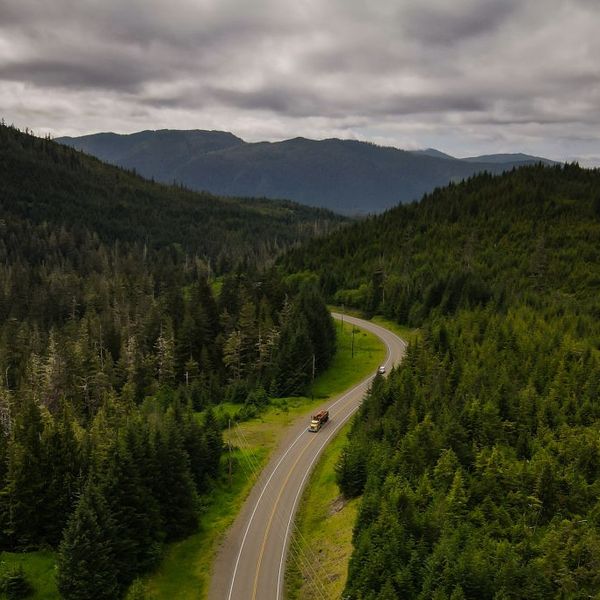
A tractor cuts down drought stricken corn, Tuesday, July 31, 2012. (Bloomberg/Getty Images)
'Things Could Get Ugly': Fracking Set to Escalate US Water Wars
Nearly half of fracking happens in places short on water
A new study released Thursday shows that a "significant portion" of fracking, a water intensive process, is happening in already water-stressed regions of the United States--most prominently Texas and Colorado, "which are both in the midst of prolonged drought conditions."
As Grist reports Friday, fracking will likely escalate "the West's water wars" as farmers and homeowners now have to contend with drillers in already drought-stricken regions.
Grist reports:
A new report from nonprofit Ceres (which maintains a neutral position on fracking in general) reveals that nearly half of the country's fracking wells are located in water-stressed regions -- in particular Texas and Colorado, where 92 percent of fracking wells are in extremely high-water-stress regions. Ceres compiled its report using data from the World Resources Institute -- which considers an area extremely water-stressed if 80 percent of its available water supply is already allocated for municipal, industrial, and agricultural uses -- and FracFocus.org, a voluntary national registry of fracking wells' locations and water usage.
FracFocus shows that between January 2011 and September 2012, the 25,450 wells in its database used 65.8 billion gallons of water, or the amount of water 2.5 million Americans use in a year. Because the site doesn't have data for every single well in the country, fracking's total water impact is likely even higher.
"These findings highlight emerging tensions in many U.S. regions between growing hydraulic fracturing activity and localized water supply needs," said Ceres president Mindy Lubber.
Monika Freyman, the report's author, told the New York Times, "You have to look at a county-by-county scale to capture the intense and short-term impact on water supplies."
"The whole drilling and fracking process is a well-orchestrated, moment-by-moment process" in which one million to five million gallons of water are needed for short periods, she said. "They [frackers] need an intense amount of water for a few days, and that's it."
The "neutral" Ceres report does not go far enough to suggest a moratorium on fracking.
However, the implications are clear enough--as the essential yet finite resource, water, continues to dwindle, frackers continue to use up excessive amounts of water to extract fossil fuels, all the while polluting large amounts of groundwater with toxic chemicals, which infect drinking wells along with swathes of land, farms, and personal property in surrounding territories.
"As summer approaches, huge areas of the Western U.S. still haven't recovered from last year's devastating drought," Claire Thompson reports at Grist. "Things could get ugly."
_______________________
An Urgent Message From Our Co-Founder
Dear Common Dreams reader, The U.S. is on a fast track to authoritarianism like nothing I've ever seen. Meanwhile, corporate news outlets are utterly capitulating to Trump, twisting their coverage to avoid drawing his ire while lining up to stuff cash in his pockets. That's why I believe that Common Dreams is doing the best and most consequential reporting that we've ever done. Our small but mighty team is a progressive reporting powerhouse, covering the news every day that the corporate media never will. Our mission has always been simple: To inform. To inspire. And to ignite change for the common good. Now here's the key piece that I want all our readers to understand: None of this would be possible without your financial support. That's not just some fundraising cliche. It's the absolute and literal truth. We don't accept corporate advertising and never will. We don't have a paywall because we don't think people should be blocked from critical news based on their ability to pay. Everything we do is funded by the donations of readers like you. The final deadline for our crucial Summer Campaign fundraising drive is just days away, and we’re falling short of our must-hit goal. Will you donate now to help power the nonprofit, independent reporting of Common Dreams? Thank you for being a vital member of our community. Together, we can keep independent journalism alive when it’s needed most. - Craig Brown, Co-founder |
A new study released Thursday shows that a "significant portion" of fracking, a water intensive process, is happening in already water-stressed regions of the United States--most prominently Texas and Colorado, "which are both in the midst of prolonged drought conditions."
As Grist reports Friday, fracking will likely escalate "the West's water wars" as farmers and homeowners now have to contend with drillers in already drought-stricken regions.
Grist reports:
A new report from nonprofit Ceres (which maintains a neutral position on fracking in general) reveals that nearly half of the country's fracking wells are located in water-stressed regions -- in particular Texas and Colorado, where 92 percent of fracking wells are in extremely high-water-stress regions. Ceres compiled its report using data from the World Resources Institute -- which considers an area extremely water-stressed if 80 percent of its available water supply is already allocated for municipal, industrial, and agricultural uses -- and FracFocus.org, a voluntary national registry of fracking wells' locations and water usage.
FracFocus shows that between January 2011 and September 2012, the 25,450 wells in its database used 65.8 billion gallons of water, or the amount of water 2.5 million Americans use in a year. Because the site doesn't have data for every single well in the country, fracking's total water impact is likely even higher.
"These findings highlight emerging tensions in many U.S. regions between growing hydraulic fracturing activity and localized water supply needs," said Ceres president Mindy Lubber.
Monika Freyman, the report's author, told the New York Times, "You have to look at a county-by-county scale to capture the intense and short-term impact on water supplies."
"The whole drilling and fracking process is a well-orchestrated, moment-by-moment process" in which one million to five million gallons of water are needed for short periods, she said. "They [frackers] need an intense amount of water for a few days, and that's it."
The "neutral" Ceres report does not go far enough to suggest a moratorium on fracking.
However, the implications are clear enough--as the essential yet finite resource, water, continues to dwindle, frackers continue to use up excessive amounts of water to extract fossil fuels, all the while polluting large amounts of groundwater with toxic chemicals, which infect drinking wells along with swathes of land, farms, and personal property in surrounding territories.
"As summer approaches, huge areas of the Western U.S. still haven't recovered from last year's devastating drought," Claire Thompson reports at Grist. "Things could get ugly."
_______________________
A new study released Thursday shows that a "significant portion" of fracking, a water intensive process, is happening in already water-stressed regions of the United States--most prominently Texas and Colorado, "which are both in the midst of prolonged drought conditions."
As Grist reports Friday, fracking will likely escalate "the West's water wars" as farmers and homeowners now have to contend with drillers in already drought-stricken regions.
Grist reports:
A new report from nonprofit Ceres (which maintains a neutral position on fracking in general) reveals that nearly half of the country's fracking wells are located in water-stressed regions -- in particular Texas and Colorado, where 92 percent of fracking wells are in extremely high-water-stress regions. Ceres compiled its report using data from the World Resources Institute -- which considers an area extremely water-stressed if 80 percent of its available water supply is already allocated for municipal, industrial, and agricultural uses -- and FracFocus.org, a voluntary national registry of fracking wells' locations and water usage.
FracFocus shows that between January 2011 and September 2012, the 25,450 wells in its database used 65.8 billion gallons of water, or the amount of water 2.5 million Americans use in a year. Because the site doesn't have data for every single well in the country, fracking's total water impact is likely even higher.
"These findings highlight emerging tensions in many U.S. regions between growing hydraulic fracturing activity and localized water supply needs," said Ceres president Mindy Lubber.
Monika Freyman, the report's author, told the New York Times, "You have to look at a county-by-county scale to capture the intense and short-term impact on water supplies."
"The whole drilling and fracking process is a well-orchestrated, moment-by-moment process" in which one million to five million gallons of water are needed for short periods, she said. "They [frackers] need an intense amount of water for a few days, and that's it."
The "neutral" Ceres report does not go far enough to suggest a moratorium on fracking.
However, the implications are clear enough--as the essential yet finite resource, water, continues to dwindle, frackers continue to use up excessive amounts of water to extract fossil fuels, all the while polluting large amounts of groundwater with toxic chemicals, which infect drinking wells along with swathes of land, farms, and personal property in surrounding territories.
"As summer approaches, huge areas of the Western U.S. still haven't recovered from last year's devastating drought," Claire Thompson reports at Grist. "Things could get ugly."
_______________________

